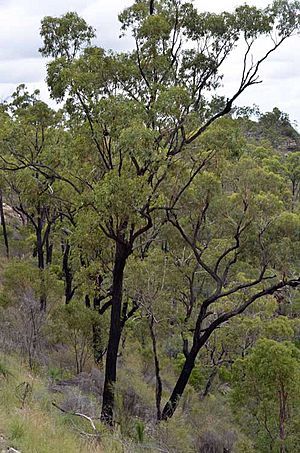Bean's ironbark facts for kids
Quick facts for kids Bean's ironbark |
|
|---|---|
 |
|
| Eucalyptus beaniana in Isla Gorge National Park | |
| Conservation status | |
| Scientific classification | |
| Genus: |
Eucalyptus
|
| Species: |
beaniana
|
Eucalyptus beaniana, also known as the Bean's ironbark, is a special type of Eucalyptus tree. This small tree is found only in Queensland, Australia. It has rough, dark bark that looks like iron, which is why it's called an "ironbark." Its leaves are long and narrow, and its flowers are white. It is only known from a few places in southern Queensland.
Contents
What Bean's Ironbark Looks Like
Bean's ironbark is a tree that grows about 10–15 m (30–50 ft) tall. It has hard, black "ironbark" on its main trunk and bigger branches. Smaller branches, thinner than about 5 mm (0.2 in), have smooth, brownish-white bark.
Young plants have long, thin leaves. These leaves are about 55–90 mm (2–4 in) long and 4–6 mm (0.16–0.24 in) wide. They grow on a short stalk called a petiole.
Adult leaves are a dull green or bluish color on both sides. They are shaped like a spear or slightly curved. These leaves are about 70–130 mm (3–5 in) long and 9–23 mm (0.4–0.9 in) wide. Their petiole is about 10–25 mm (0.4–1 in) long.
The flower buds grow in groups of seven. They are mostly found at the ends of the branches. Each group of buds is on a branched stalk called a peduncle, which is 5–11 mm (0.2–0.4 in) long. Each individual flower bud has its own small stalk, a pedicel, about 3–5 mm (0.12–0.20 in) long.
Mature buds are shaped like a club or spindle. They are about 4–7 mm (0.16–0.28 in) long and 2–4 mm (0.079–0.16 in) wide. The cap of the bud, called the operculum, is usually as long as the flower cup.
Bean's ironbark flowers in September. Its flowers are white. After flowering, the tree produces woody, cup-shaped fruits. These fruits are called capsules. They are about 4–6 mm (0.16–0.24 in) long and 3–6 mm (0.1–0.2 in) wide. They sit on a pedicel about 2–7 mm (0.079–0.28 in) long.
Eucalyptus beaniana is similar to another tree called E. taurina. However, you can tell them apart by looking at their young leaves. Bean's ironbark has thinner, more linear young leaves. It also has more smooth bark on its branches.
How Bean's Ironbark Got Its Name
The Bean's ironbark was officially described in 1991. This was done by two botanists, Ken Hill and Lawrie Johnson. They wrote about it in a science journal called Telopea.
They found samples of the tree near the Isla Gorge lookout carpark in 1984. The tree was named beaniana to honor Anthony Bean. He was one of the people who helped collect the samples.
Where Bean's Ironbark Lives
Bean's ironbark grows in shallow, sandy soils. It is found in woodland areas with other eucalypt trees. These areas are usually on sandstone ridges.
This tree is known from only four places in south-east Queensland. These locations include the Isla Gorge National Park, and areas near Taroom, Cracow, and Mundubbera.
Protecting Bean's Ironbark
Bean's ironbark is considered a "vulnerable" species. This means it is at risk of becoming endangered if we don't protect it.
Its vulnerable status is recognized by two important laws:
- The Australian Government's Environment Protection and Biodiversity Conservation Act 1999
- The Queensland Government's Nature Conservation Act 1992
These laws help protect the tree and its habitat.



